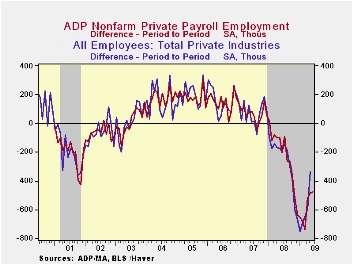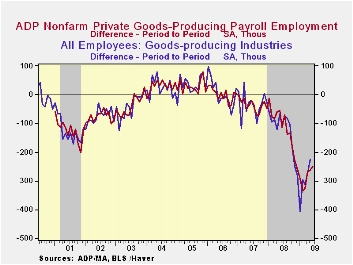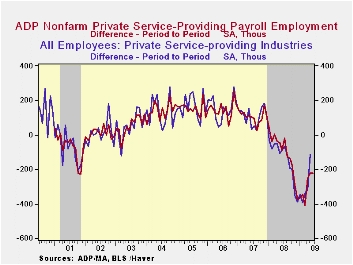 Global| Jul 01 2009
Global| Jul 01 2009ADP Report: Rate Of Job Loss Lessens A Bit
by:Tom Moeller
|in:Economy in Brief
Summary
While a turn to positive growth in employment still is not at hand, the June report from the payroll processor ADP in their National Employment Report again showed an easing in the rate of contraction. It indicated that private [...]
 While
a turn to positive growth in employment still is not at hand, the June
report from the payroll processor ADP in their National Employment
Report again showed an easing in the rate of contraction. It indicated
that private nonfarm payrolls fell 473,000 last month after a revised
485,000 May decline that was shallower than reported initially. The
latest reading was the seventeenth consecutive monthly decline, but the
annualized rate of decline in payrolls eased somewhat to 5.2% during
the last three months from its peak of 7.1% in March.
While
a turn to positive growth in employment still is not at hand, the June
report from the payroll processor ADP in their National Employment
Report again showed an easing in the rate of contraction. It indicated
that private nonfarm payrolls fell 473,000 last month after a revised
485,000 May decline that was shallower than reported initially. The
latest reading was the seventeenth consecutive monthly decline, but the
annualized rate of decline in payrolls eased somewhat to 5.2% during
the last three months from its peak of 7.1% in March.
ADP compiled the estimate from its database of individual companies' payroll information. Macroeconomic Advisers, LLC, the St. Louis economic consulting firm, developed the methodology for transforming the raw data into an economic indicator.
 The
U.S. Bureau of Labor Statistics will report June payroll employment
tomorrow. For comparison, May's
485,000 worker decline in ADP's measure of private nonfarm payrolls was
accompanied by 338,000 job losses in the BLS measure of private sector
payrolls.According to
ADP and Macro-Advisers, the correlation between the monthly percentage
change in the ADP estimate and that in the BLS data is 0.90.
The
U.S. Bureau of Labor Statistics will report June payroll employment
tomorrow. For comparison, May's
485,000 worker decline in ADP's measure of private nonfarm payrolls was
accompanied by 338,000 job losses in the BLS measure of private sector
payrolls.According to
ADP and Macro-Advisers, the correlation between the monthly percentage
change in the ADP estimate and that in the BLS data is 0.90.
ADP reported that last month smaller medium-sized payrolls remained in forefront of monthly job loss and fell another 205,000 (-5.6% y/y) followed by a 177,000 (-4.2% y/y) worker decline in small-sized payrolls. Large payrolls fell by 91,000 (-5.5% y/y). In the goods producing sector there were 250,000 fewer jobs in June (-12.7% y/y). Details in the goods sector show that medium-sized payrolls fell 108,000 (-13.2% y/y) followed by a 90,000 (-12.0% y/y) shortfall in small-sized payrolls. Large payrolls fell 52,000 (-12.8% y/y). In the manufacturing sector alone, payrolls fell 146,000 (-12.5% y/y).
 Declines in employment in
the service producing industry continued to
lag just slightly the factory sector's workforce contraction with a
223,000 (-3.1% y/y) decline, the fifteenth consecutive monthly decline.
Medium-sized service payrolls fell 97,000 (-3.5% y/y) and small-sized
payrolls dropped 87,000 (-2.7% y/y). Large service producing payrolls
dropped by 39,000 (-3.4% y/y).
Declines in employment in
the service producing industry continued to
lag just slightly the factory sector's workforce contraction with a
223,000 (-3.1% y/y) decline, the fifteenth consecutive monthly decline.
Medium-sized service payrolls fell 97,000 (-3.5% y/y) and small-sized
payrolls dropped 87,000 (-2.7% y/y). Large service producing payrolls
dropped by 39,000 (-3.4% y/y).
The ADP National Employment Report data is maintained in Haver's
USECON database; historical figures date back to December 2000. The figures in this report cover only private sector jobs and exclude employment in the public sector, which rose an average 11,083 during the last twelve months.The full ADP National Employment Report can be found here
,and the ADP methodology is explained here.| LAXEPA@USECON | June | May | Y/Y | 2008 | 2007 | 2006 |
|---|---|---|---|---|---|---|
| Nonfarm Private Payroll Employment (m/m Chg.) | -473,000 | -485,000 | -4.9% | -0.4 | 1.2% | 2.0% |
Tom Moeller
AuthorMore in Author Profile »Prior to joining Haver Analytics in 2000, Mr. Moeller worked as the Economist at Chancellor Capital Management from 1985 to 1999. There, he developed comprehensive economic forecasts and interpreted economic data for equity and fixed income portfolio managers. Also at Chancellor, Mr. Moeller worked as an equity analyst and was responsible for researching and rating companies in the economically sensitive automobile and housing industries for investment in Chancellor’s equity portfolio. Prior to joining Chancellor, Mr. Moeller was an Economist at Citibank from 1979 to 1984. He also analyzed pricing behavior in the metals industry for the Council on Wage and Price Stability in Washington, D.C. In 1999, Mr. Moeller received the award for most accurate forecast from the Forecasters' Club of New York. From 1990 to 1992 he was President of the New York Association for Business Economists. Mr. Moeller earned an M.B.A. in Finance from Fordham University, where he graduated in 1987. He holds a Bachelor of Arts in Economics from George Washington University.






